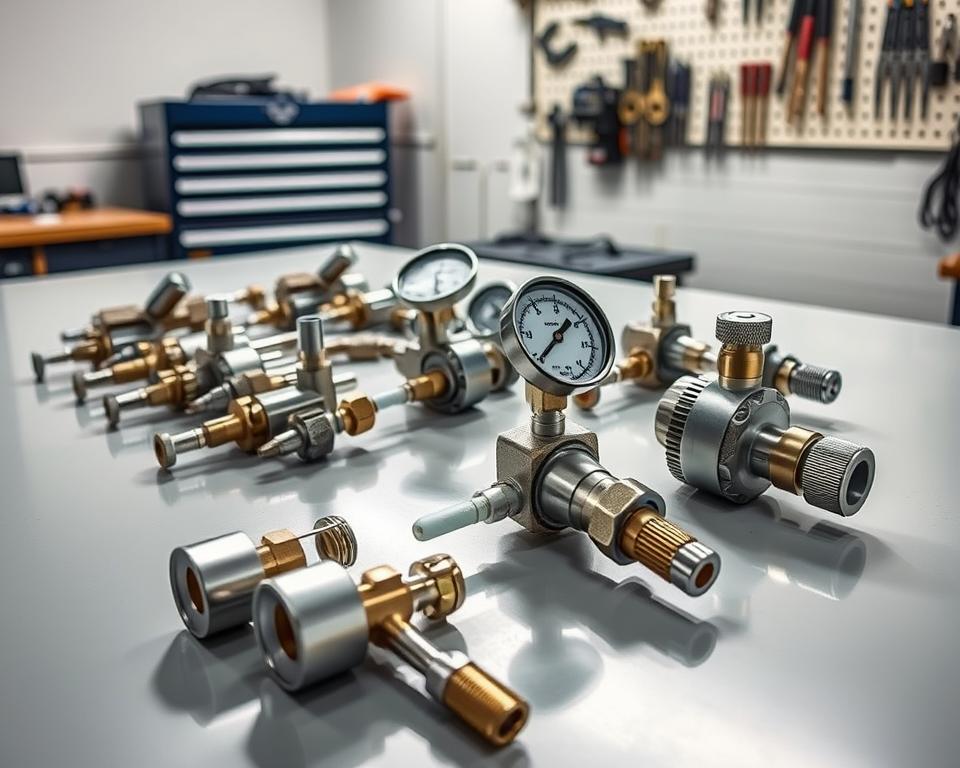CO2 Regulator Fittings – Vital Guide & Tips
Did you know that primary regulators in CO2 systems lower tank pressure from 800-900 psi to a more practical 10-30 psi? This not only demonstrates the efficiency of CO2 regulator fittings but reinforces their critical role in ensuring a ideal pour. They are essential in applications like kegerators, aquariums, and industrial applications. Understanding CO2 tank fittings is fundamental for top operation and dependability.
CO2 regulator fittings greatly influence the quality and palatability of carbonated beverages. Choosing premium CO2 regulator fittings can preserve steady gas pressure, warding off excessively or insufficiently carbonated beer issues. It’s important to select first-rate CO2 fittings from trusted sources like Installation Parts Supply. This secures endurance and efficiency. We will discuss multiple fitting variants, installation advice, maintenance tips, and choosing strategies for particular requirements.
Critical Findings
- Key regulators are indispensable in cutting high CO2 tank pressure for perfect serving.
- Different beer styles necessitate unique carbonation settings to achieve the optimal flavor.
- Consistency in gas pressure is vital to avoid excessively or insufficiently carbonated beverages.
- Additional regulators play a key role when handling multiple kegs at diverse pressures.
- Opting for high-quality fittings from trusted brands can improve system reliability.
Introduction to CO2 Regulator Fittings
CO2 regulator fittings are crucial in controlling carbon dioxide flow and pressure throughout multiple applications. Such uses include beverage dispensing, aquaculture, and healthcare applications. They regulate the CO2 pressure from a substantial range (800 to 1000 PSI) to a more moderate range (1 to 40 PSI). This conversion is essential for the dependable functioning of CO2-dependent devices.
The primary parts of CO2 regulator fittings include the regulator and shut-off valve. The regulator sustains desired pressure levels, while the shut-off valve supplies operator-controlled gas flow control. A noteworthy safety feature is the check valve. It works to stop back-siphoning, preserving the system’s integrity. In aquatic setups, securing stable pH levels through exact CO2 delivery is vital. Tools such as bubble counters and pH controllers are critical in this process, aiding in plant health.
Choosing reliable CO2 regulator fittings is essential to optimal performance in different environments. When selecting fittings, it’s crucial to assess the match of materials with CO2. For instance, silicone tubing may permit gas to leak out, which could cause losses. Opting for top-grade needle valves can ward off problems like ‘end of tank dumps.’ This ensures safety and maintains consistent CO2 delivery.
How CO2 Regulator Fittings Work
CO2 regulator fittings play a pivotal role in the efficiency and integrity of CO2 systems. They help maintain steady pressure, key to proper carbonation in drinks. High-pressure CO2 tanks, holding 800 to 900 psi, need their pressure reduced to a manageable 10-30 psi. Such pressure lowering is essential for serving at the right carbonation levels. Primary regulators, key parts of CO2 regulator fittings, enable this process. They frequently include a gauge or dual gauges to display the gas pressure.
Regarding serving beer, the operation of these fittings becomes paramount. Uneven pressure may impair the integrity of the pour. Consequently, the outcome may be beer that’s either excessively carbonated or lacking carbonation. Since different beer types necessitate unique carbonation levels, like stouts requiring lower carbonation than lagers, additional regulators play a vital role. They permit fine-tuning based on the individual requirements of each keg.

For mobile serving, such as with smaller 74 gram CO2 tanks, mobile beer regulators are perfect. They allow serving from a small setup, capably delivering a 1/4 barrel. Opting for trustworthy CO2 system fittings is critical. Examples include Taprite are well-known for reliable regulators, enhancing the brewing process.
| Regulator Type | Pressure Range | Use Case |
|---|---|---|
| Primary Regulator | 10-30 | Used for serving standard beer styles |
| Dual Gauge Regulator | 0-60 | Displays tank pressure and serving pressure |
| Secondary Regulator | Fluctuates | Adjusts pressure for multiple kegs |
| Mobile Beer Regulator | 10-14 | Ideal for on-the-go serving from small tanks |
Knowing the roles and specs of CO2 regulator fittings can enhance a serving setup. Consistently monitoring pressure gauges and fittings guarantees that the system functions perfectly. This diligence leads to superior service quality.
Categories of CO2 Regulator Fittings
As you select CO2 regulator fittings, it’s essential to know the categories available for peak performance in various scenarios. The key types are single gauge and dual gauge regulator fittings. Each serves distinct purposes, suiting the requirements of different environments from entry-level home brewing to advanced industrial operations.
Single Gauge Regulator Fittings
Intended for basic tasks, single gauge regulator fittings are ideal for manual adjustment needs. They include a sole gauge displaying the gas’s output pressure. Ideal for compact systems like home kegerators or small breweries, they offer a straightforward approach. Manufacturers like Brewmaster and Fermentap are known for offering user-friendly and reliable solutions.
Dual Gauge Regulator Fittings
Dual gauge regulator fittings are designed to provide more comprehensive monitoring by indicating both the operating and reserve pressures. They are vital for advanced operations, including professional brewing. This dual info helps users avert issues like keg explosions or gas leaks. For users seeking higher accountability, options including KOMOS and Taprite provide numerous dual gauge options.
| Category | Benefits | Best For | Notable Brands |
|---|---|---|---|
| Single Gauge Regulator Fittings | Simple use, easy adjustments | Home brewing, small kegerators | Brewmaster / Fermentap |
| Dual Gauge Regulator Fittings | Accurate dual readings | Commercial brewing, complex systems | KOMOS, Taprite |
Deciding on the Right CO2 Regulator Fittings for Your Requirements
Opting for the right CO2 regulator fittings requires critical considerations. These aspects improve the CO2 system’s functionality and safety. First, assess the pressure range that meets your application, confirming the fittings support the specific PSI levels. You must verify compatibility with CO2 sources like CGA-320 valves for a seamless connection. Also, focus on durability to avoid leaks and malfunctions in your CO2 system.
Key Considerations for Fitting Selection
- Pressure Range: The fittings need to support your system’s pressure demands.
- Build Quality: Choose durable materials, such as stainless steel, for robustness.
- Compatibility: Ensure the fittings are compatible with your CO2 sources.
- Ease of Installation: Seek out designs that are easy to install.
Top Brands for Superior CO2 Regulator Fittings
Prioritizing well-established brands is vital for the best system performance. Installation Parts Supply is noted for supplying high-quality CO2 regulator fittings. Their selections strike a balance between quality and cost, meeting the needs of hobbyists and professionals. The Milwaukee MA955 solenoid, costing approximately $40 CAD, is praised for its efficient operation and reliability. Additionally, the Aqualabs regulator and the Dici regulator with a bubble counter are budget-friendly, available for $50 to $60 CAD on Amazon. These brands are superior options for enhancing your aquarium system.
How to Install CO2 Regulator Fittings
Installing CO2 regulator fittings necessitates a focus on fine details and observance of essential safety measures. An accurate installation ensures that the system works efficiently. It also prevents leaks that could be hazardous. For a secure and effective setup of CO2 regulator fittings, keep these tips in mind:
- Start by inspecting the shut-off valve. Confirm it is in the off position before continuing with installation, as this stops unexpected gas discharge during the setup procedure.
- Utilize proper sealing methods on the threaded interfaces. Teflon tape is excellent to ensure a secure fit without any leak risk.
- Adjust the pressure settings on your CO2 regulator correctly, which is key to reaching ideal carbonation and avoiding over-pressurization.
- Following installation, vent the gas step-by-step to enable precise gauge readings and ensure that any trapped air is removed from the system.
- After installation, conduct a thorough inspection for any signs of leaks. Utilizing a soapy water solution can help identify potential leak points, confirming a secure system.
Following these guidelines, you can greatly enhance both the efficiency and security of your dispensing system.
CO2 Regulator Parts: Maintenance and Troubleshooting
To maintain peak performance of your CO2 regulator fittings, regular maintenance and timely troubleshooting are crucial. Consistent monitoring reveals issues promptly. Checking for leaks is indispensable. Soap tests reveal leaks through bubble formation.
Tightening internal parts correctly is key, with a 7/8 socket wrench suggested for optimal tightening. Securing the regulator properly enhances longevity. Use 75 foot/lbs of torque when reattaching the bonnet. A properly working regulator will display over 40 PSI. An extra 1/4 turn may be needed to achieve the right pressure.
Improper installation or missing washers often cause leaks, draining CO2 tanks quickly. Beer regulator pressure relief valves are designed to trigger under 60 PSI. However, some may release at higher pressures due to issues. Diaphragm or cartridge failure often necessitates regulator rebuilds.
Various manufacturers deliver different performance. The Milwaukee MA957, though popular, is sometimes criticized for needle valve problems and comes with a 6-month warranty. A 5-year warranty from CMBecker underscores product reliability.
Timely maintenance increases the longevity of CO2 systems. Understanding your regulator’s specifications, such as Taprite’s 0-50 PSI range, facilitates effective troubleshooting. Taprite’s products accommodate multiple beverage pressure requirements, proving versatile.
Affordable CO2 Fittings vs. Premium CO2 Regulator Fittings
The decision between budget-friendly CO2 fittings and premium CO2 regulator fittings rests on their price. Lower-cost options might start at $20, whereas premium products often start at $200. For instance, a economical CO2 setup with a no-frills regulator on a standard 5 lb cylinder could cost between $150 to $175. On the other hand, a top-quality CO2 system could cost up to $625, based on brand and performance.
The dependability of CO2 systems largely depends on the quality of their components. It is commonly observed that premium regulators offer exact pressure modulation, crucial for tanks smaller than 10 gallons. Furthermore, over 50% of users favor fully assembled setups, for the sake of convenience and proven quality. When components are compiled by companies, rather than manufactured, prices may vary significantly.
There’s potential for savings when individuals opt to buy parts separately and assemble themselves by approximately 20-30% versus pre-assembled kits. Component costs, such as those for solenoids and metering valves, vary widely. Solenoids are priced from $20 to $50, while the cost of metering valves spans from $17 to beyond $200, based on quality and performance.
At about $60, a 5 lb aluminum CO2 tank is a factor in the total expense. Users have mixed opinions on products like the KOMOS® Premium Dual Gauge CO2 Regulator, which is priced at $59.99. It functions up to 60 PSI with a maximum flow rate that is not specified. This regulator includes a pressure relief valve that triggers at 65 PSI.
In terms of durability and efficiency, nearly 70% of users are pleased and about 80% would endorse it for homebrewing. Nevertheless, issues like slow leaks affect roughly 10% of users. The willingness to invest more stems from a desire for dependable performance, an essential factor in choosing between budget-friendly and premium CO2 fittings and regulators.
In Summary
Opting for the ideal CO2 regulator fittings is essential for your system’s performance, security, and cost-effectiveness. We detailed critical points, including categories of CO2 regulator fittings and factors to guide your decision. An appropriate regulator is essential for consistent carbonation in draft beer and long-term system dependability.
Premium fittings often have a higher upfront cost but provide better durability and ease of maintenance. High-quality brands like Airgas, Taprite, and Micromatic offer superior reliability. They cater to varied user requirements, ensuring durability and long-term performance.
It is recommended to consult trusted suppliers like Installation Parts Supply when setting up or upgrading a CO2 system. Obtaining high-quality products along with expert guidance can significantly boost your system’s performance. Quality fittings are an investment in the efficiency of both homebrewing setups and commercial operations.
FAQ
Can you explain the function of CO2 regulator fittings?
CO2 regulator fittings control the flow and pressure of CO2 in systems such as kegerators, aquariums, and diverse systems. They serve an important function in guaranteeing the system’s efficiency and security by controlling CO2 levels.
Which types of CO2 regulator fittings exist?
The primary types are single gauge and dual gauge regulator fittings. Single gauge fittings suit simpler setups like home kegerators, offering manual control. Dual gauge fittings provide detailed pressure data and are well-suited for commercial and advanced applications.
What factors should I consider when choosing CO2 regulator fittings?
Selecting the right CO2 regulator fittings necessitates assessing the required pressure levels, fit with your CO2 supply, and construction quality. Ensure high durability and safety to prevent leakage and promote optimal operation.
Which brands are known for excellent CO2 regulator fittings?
Brands like Installation Parts Supply offer top-quality CO2 regulator fittings. Choosing reputable brands enhances your system’s safety and performance.
Can you provide installation guidelines for CO2 regulator fittings?
For successful installation, ensure all connections are tight to avoid leaks. Properly adjust the pressure and vent gas sequentially for accurate readings. Consult detailed installation guides for further assistance.
How should I maintain my CO2 regulator fittings?
Routine care is key to keeping your system running smoothly. Regular leak inspections, pressure recalibrations, and addressing minor issues are vital. Such practices ensure your system performs optimally.
Is it worthwhile to invest in high-end CO2 regulator fittings?
Definitely, premium fittings from trusted manufacturers can reduce overall costs by lowering maintenance and replacement expenses. They ensure superior performance and dependable operation.


